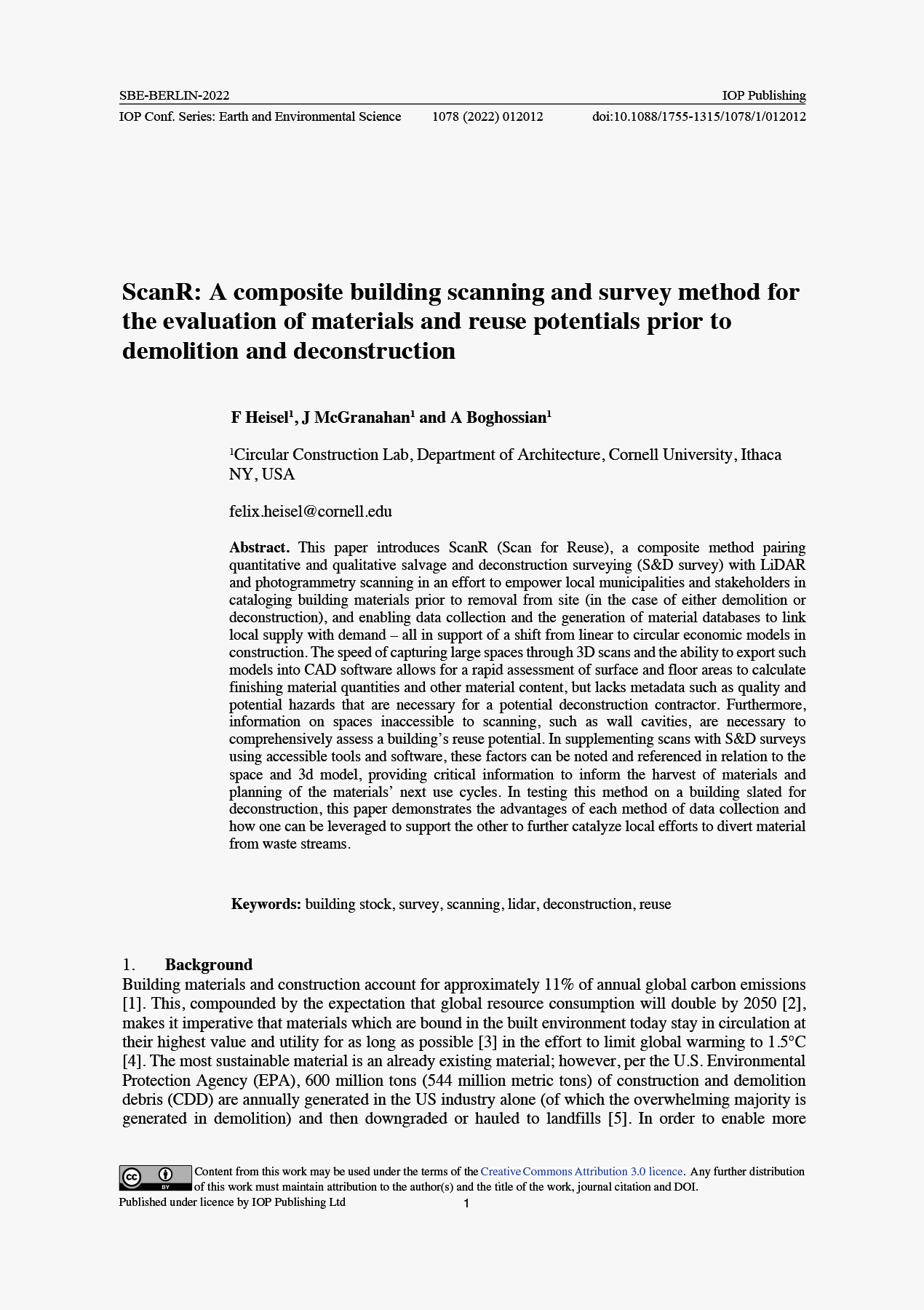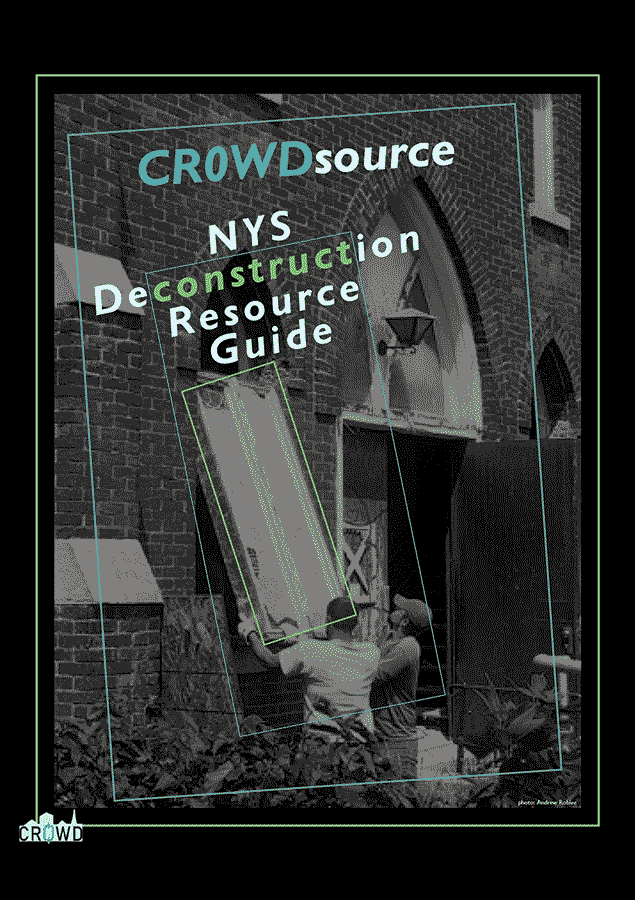Constructing a Circular Economy in New York State: Deconstruction and Building Material Reuse
This new White Paper "Constructing a Circular Economy in NYS: Deconstruction and Building Material Reuse" provides an in-depth perspective on the State's current linear construction economy and an assessment of the economic, environmental, and social potential of deconstruction and reuse. The paper concludes with a set of state level policy and practice recommendations to aid policymakers, and local and state government agencies, in the development of a circular economy in New York State.
Deconstruction Request for Proposals
The Circular Construction Lab at Cornell University recommends the adoption of a Deconstruction Request for Proposals (D-RFP) to facilitate, organize and make comparable bids for proposed deconstruction projects. The attached document can be understood as a template summarizing important aspects of deconstruction projects (especially in comparison to demolition projects), as well as necessary accounting requirements as part of the Materials Management Plan. Working within the regulations set forth by the Deconstruction Ordinance, the D-RFP requires the issuer (owner or owner-representative) to provide certified deconstruction contractors (bidders) with a scope of work (see “I. Scope of Work”) and related work requirements (see “II. RFP Submittal Requirements”). After a set submittal deadline, the issuer then has a period of time to select the preferred contractor to perform the deconstruction.
High-resolution combined building stock and building energy modeling to evaluate whole-life carbon emissions and saving potentials at the building and urban scale
This article describes the development of a high-resolution combined building stock model (BSM) and building energy model (BEM) on both building and urban scale using all residential buildings of Ithaca, NY, USA as a case study. The model offers a holistic, detailed and local perspective on operational and embodied carbon emissions, associated saving potentials at both the building and urban scale, and the linkages, trade-offs and synergies between buildings and energy use as a basis for decision-making.
Calculation and evaluation of circularity indicators for the built environment using the case studies of UMAR and Madaster
This paper describes the process of documenting materials and products utilized in the construction of the Urban Mining and Recycling (UMAR) unit within the Madaster platform. UMAR is a fully circular residential unit of Empa NEST created from secondary resources and designed as a material depot for future constructions. Madaster is an online platform, which generates and registers materials passports and calculates a Circularity Indicator for their construction, use, and end-of-life phases.
ScanR: A composite building scanning and survey method for the evaluation of materials and reuse potentials prior to demolition and deconstruction
This paper introduces ScanR (Scan for Reuse), a composite method pairing quantitative and qualitative salvage and deconstruction surveying (S&D survey) with LiDAR and photogrammetry scanning in an effort to empower local municipalities and stakeholders in cataloging building materials prior to removal from site (in the case of either demolition or deconstruction), and enabling data collection and the generation of material databases to link local supply with demand – all in support of a shift from linear to circular economic models in construction.
RhinoCircular: Development and Testing of a Circularity Indicator Tool for Application in Early Design Phases and Architectural Education
RhinoCircular is a CAD plugin developed within the Circular Construction Lab (CCL) at Cornell University that assesses a building design’s environmental impact in respect to its embodied carbon values and circularity: the degree to which design solutions minimize extraction and waste in favor of reusable, recyclable and renewable material resources. Buildings and regions need to anticipate stocks and flows of materials, documenting and communicating which materials in what quantities and qualities become available for reuse or recycling where and when. RhinoCircular allows direct and immediate feedback on design decisions in respect to formal deliberations, structural considerations, material selection and detailing based on material passports and circularity indicators. It can be integrated in existing and complex workflows and is compatible with industry standard databases while providing its own essential dataset complementing missing information.
CR0WD Deconstruction Local Government Guide
Faced with housing crises, aging building stock, landfill concerns, and climate impacts to the built environment, municipalities and states are increasingly turning their attention to deconstruction and building material reuse as an alternative to demolition.
Providing examples along the way,this guide outlines what deconstruction means, why moving away from demolition is beneficial, and how local governments can successfully kick-start deconstruction in their communities.
CR0WD Deconstruction Resource Guide
The CR0WDsource New York State Deconstruction Resource Guide is a short guidebook created to provide a brief overview of the importance of deconstruction, the monetary and sequestered carbon value of salvaged materials, and an extensive directory of existing resources in New York State already engaging in salvage, reuse, and deconstruction.
Circular fit-out in retail stores
The circular transition is an urgent matter for the retail sector and a necessary step for companies to align with the European Green Deal. Moving towards a truly circular economy will not be achieved in one step.
This report is intended to raise awareness on circular design approaches for the fit-out of stores, as part of a more comprehensive strategy for the transition toward a circular built retail environment.










